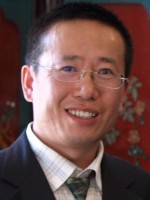abstract
Modularmixed metal-organic frameworks with lanthanide centres 2- M(4)[M(12)V(24)O(24)(OH)(8)(H(2)hedp)(8)(Hhedp)(16)(H(2)O)(64+n)]. 88+y(H(2)O) (M(3+) = Y(3+), Ce(3+), Sm(3+), Eu(3+), Tb(3+), Gd(3+), Er(3+); H(5)hedp = etidronic acid), have been reported. The compounds have been prepared by (i) slow evaporation of the solvent to afford large single-crystals of the Y(3+), Ce(3+) and Er(3+)compounds and (ii) facile one-pot synthesis (at ambient conditions) overnight to yield microcrystalline Y(3+), Ce(3+), Sm(3+), Eu(3+), Tb(3+) and Gd(3+) solids. Framework construction has been shown to be modular and based on the self-assembly of cyclic trinuclear [V(3)O(3)(OH)(H(2)hedp)(Hhedp)(2)](6-) anionic units with cationic {MO(8)}) or {MO(9)} aqua-based lanthanide complexes (with dodecahedral, square antiprismatic or tricapped trigonal prismatic coordination geometries), which gives rise to unprecedented trinodal networks (having and 4-connected nodes) with a total Schafli symbol of (4.8(3).10(2)}(2){4(2).8(4)}{8}(2). The anionic charge of the networks is balanced by highly disordered trivalent lanthanide cations in the channels. The compounds have been studied by single-crystal and powder X-ray diffraction, vibrational spectroscopy (FTIR), thermogravimetry, optical and scanning electron microscopy and elemental analysis. The photoluminescence properties of selected compounds have been investigated. Intriguingly, the co-existence of V(4+) and Eu(3+) cations in the same material allows the fine tuning of the photoluminescence emission from white to purplish-blue, by changing the excitation wavelength. (C) Wiley-VCH Verlag GmbH & Co. KGaA, 69451 Weinheim, Germany, 2009)
keywords
SELECTIVE GAS-ADSORPTION; INORGANIC 3D NETWORKS; COORDINATION POLYMERS; CRYSTAL-STRUCTURE; HYDROGEN STORAGE; HYDROTHERMAL SYNTHESIS; MAGNETIC-PROPERTIES; THERMAL-STABILITY; DICHOTOMY METHOD; ACID
subject category
Chemistry
authors
Rocha, J; Paz, FAA; Shi, FN; Ferreira, RAS; Trindade, T; Carlos, LD
our authors
Projects
Nanogotas de Água em Materiais Microporosos e Híbridos Orgânicos-Inorgânicos (PTDC/QUI/65805/2006)
acknowledgements
We are grateful FSE and Fundacao para a Ciencia e a Tecnologia (Portugal) for their general financial support (PPCDT/QUI/58377/2004 and PTDC/QUI/65805/2006 supported by FEDER).







